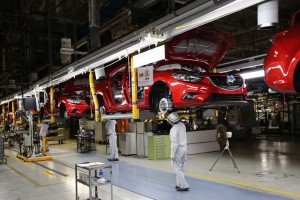It’s long billed itself as the “zoom-zoom” car company, but it’s not the performance of products like the little Mazda roadster or the new Mazda6 sedan that has the Japanese maker crowing this week.
Expected by some industry observers to face serious problems after the break-up of its long-running relationship with Ford Motor Co., Mazda had been delivering plenty of surprises lately, including a solid profit for the most recent quarter.
And the maker says a key ingredient has been finding a way to ramp up the speed of its key assembly plant in Hofu to a pace even competitors like Toyota have to admire and envy. The nearly 31-year-old Hofu plant — which celebrated the production of its 10 millionth vehicle this week – is now rolling them off the line at an industry-leading rate of one every 54 seconds.
By comparison, Toyota Motor Corp., whose manufacturing system has long been considered an industry benchmark, takes anywhere from 57 to 115 seconds to roll out a new vehicle.
Mazda needs every car, truck and crossover it can produce. After some years of sluggish sales during the global automotive recession, the maker is quickly regaining ground. In the critical U.S. market, for example, demand was up 4.2% for the first seven months of 2013, On a global scale, Mazda is aiming for a nearly 40% increase in sales by the end of its fiscal year in March 2016, to 1.7 million, up from 1.23 million for the 2012 fiscal year that ended March 31st.
And Hofu is carrying a large share of the load, with production expected to reach 400,000 in 2013, up from 350,000 last year.
Part of the reason is that Mazda walked away from its suburban Detroit-based joint venture, known as Auto Alliance, in 2012, transferring production to Japan with the launch of the all-new Mazda6 midsize sedan.
For the moment, the vast majority of its production is centered in Japan – in sharp contrast to competitors like Honda and Nissan who have steadily moved manufacturing off the home islands. A full 94% of the products assembled in Hofu will be exported, according to Mazda officials.
Mazda will open up a new factory in Mexico next year, the facility set to service the booming Latin American market and other export regions. But Hofu, which is known in the company as the “mother plant,” will remain the center of Mazda’s production base. And if the fifth-largest Japanese maker can meet its ambitious sales targets Hofu might soon match its previous peak, when it produced 500,000 vehicles in 2007.
“We see this as one step towards further growth,” Mazda President Masamichi Kogai proclaimed as the 10 millionth vehicle, a 2014 Mazda6, reached the end of the Hofu line.
One of the reasons for the maker’s manufacturing efficiency is its strategy of extensive platform sharing, allowing different models to roll down the same line since they share the same underlying chassis. Mazda is betting that will not only speed up production but help it improve its overall economies of scale.
About 80% of the company’s volume is soon expected to come from the new SkyActiv architecture, a new approach meant to reduce mass, as well as cost, and deliver significantly better fuel economy along with increased margins.
Mazda has also developed new powertrains for the SkyActiv system, including both gasoline engines as well as diesel. It will, in fact, soon become the only Japanese maker to provide a diesel in its U.S. passenger car line-up. The maker also announced this week plans to boost production of SkyActiv engines by 25% by the end of next year.
Despite its recent success, not everyone is convinced Mazda has achieved a critical turnaround. Skeptics warn that – much like its bigger Japanese competitors – Mazda’s recent earnings were buoyed by a dramatic shift in yen/dollar exchange rates. They caution that profits could just as quickly tumble if the yen regains some strength.
But for now, Mazda officials are upbeat and confidently predicting sales, margins and earnings are on the mend. And as long as they’re right, Hofu will keep zooming out new vehicles at a pace the rest of the industry can only envy.

